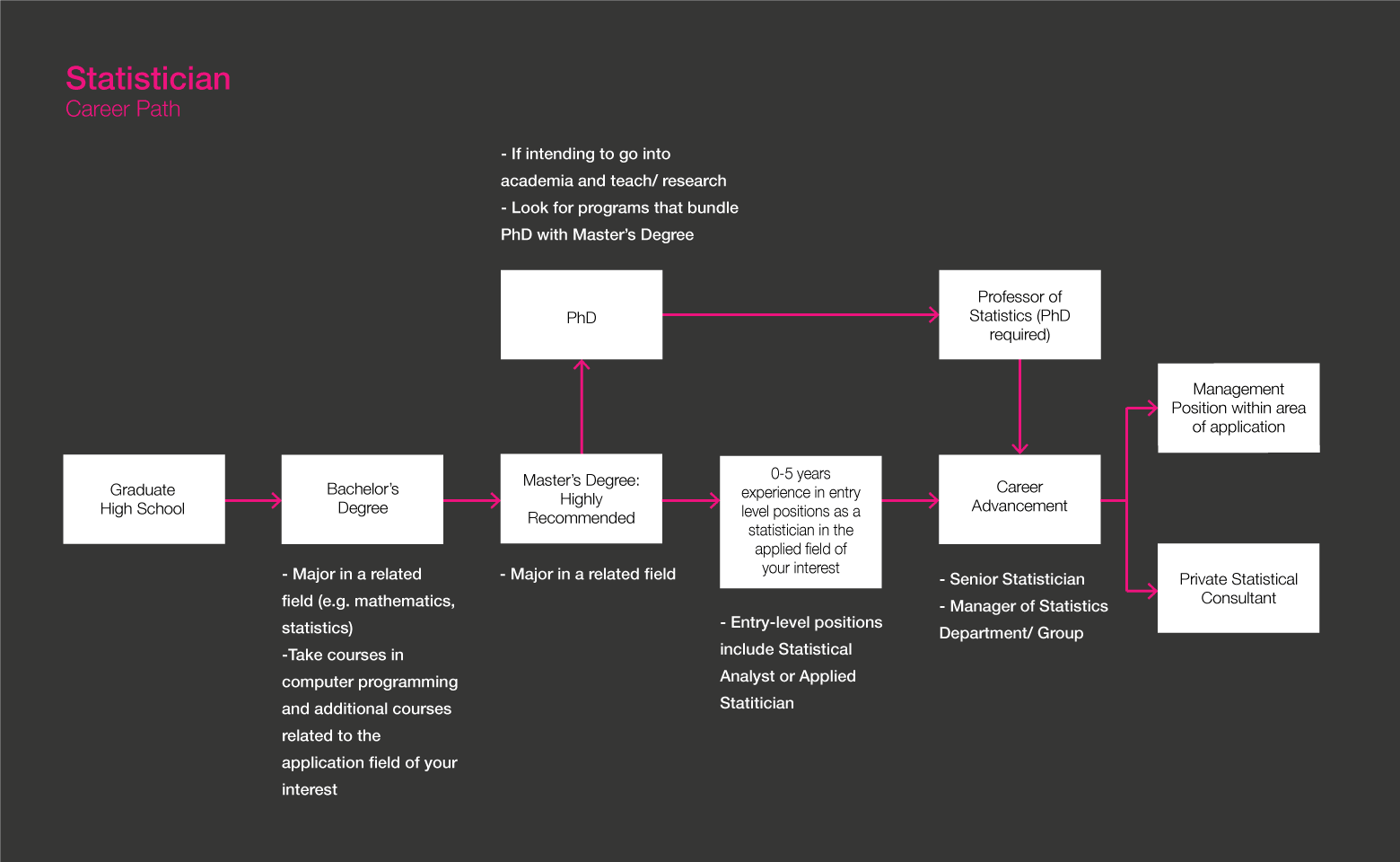Spotlights
Similar Titles
- Statistical Analyst
- Trend Investigator Analytical Statistician
- Applied Statistician
- Mathematical Statistician
- Private Statistical Consultant
Job Description
Statisticians design and conduct studies to accumulate, organize and analyze data for practical application, using principles of mathematics and statistical theory.
Rewarding Aspects of Career
- Applying statistical analysis within a variety of fields (e.g. agriculture, healthcare, economics, etc.) keeps the job interesting and goes hand in hand with learning about diverse topics and interacting with professionals from many different backgrounds
- Intellectual stimulation and the chance to be creative when solving problems
- Satisfaction from determining and communicating useful information that will serve society
- Provides the ability to think rationally about presented information and take calculated, informed actions that come in handy when buying a house, eating a healthy diet, etc.
The Inside Scoop
Job Responsibilities
- Design surveys, experiments, opinion polls, or other methods of study to collect data
- Apply and/or develop mathematical or statistical models to analyze data
- Data entering and processing using computers (compiling, coding, categorizing, calculating, tabulating, auditing, or verifying information or data)
- Interpret data (e.g. identifying trends)
- Communicate conclusions drawn from their analyses in written form (e.g. analytical reports), e-mail, or in-person presentations (often with visual/graphical representations)
Skills Needed
Soft Skills
- Written and oral communication skills
- Analytical skills
- Critical thinking/Problem-solving
Hard Skills
- Proficiency in mathematics and statistical theory
Technical Skills
- Analytical software: SAS (Statistical Analysis System), The MathWorks MATLAB
- Database software: Microsoft Access, Structured query language (SQL)
Different Types of Organizations
- Government: conducting research to advise policymakers
- Healthcare: pharmaceutical companies, public health agencies, or hospitals
- Education:
- Teaching and/or conducting research at college/university or even teaching high school
- Researching and advising Department of Education
- Businesses/Companies: design experiments that test products to advise developers on their efficiency or advise marketers on advertising strategies and pricing
- Journalism
- Private consulting firms
Expectations and Sacrifices
Becoming a statistician requires many years of education, training, and experience which is time consuming and hard work
Current Trends
- Today, data is collected in such great volumes that statisticians are relying more on computational statistics derived from advanced computers and algorithms, in addition to traditional methods of analysis (e.g. sampling data, interpreting results, etc.)
- Examples of computational statistics tasks are statistical programming, econometrics, operations research, etc.
Education and Training Needed
Basic Requirements
- Master’s degree in a quantitative field (preferably mathematics or statistics)
- Typical majors are mathematics or statistics; however, students may also study topics such as computer science, life sciences, or physical sciences to prepare for specific roles
- Be advised that a Bachelor’s degree will typically only qualify an applicant for entry-level positions
- Per O*Net Online, 65% of Statisticians reported having a master’s, 20% a PhD, and 15% a bachelor’s
- If you have an idea of a field of application you would be interested in working within, taking courses in related subjects (e.g. economics, computer science, engineering, physics, biology, chemistry, health sciences, etc.) is encouraged as it boosts your candidacy for employment within that field
- Alternatively, taking classes in a variety of these classes may help you determine the field of application you would be interested in
- Many employers look favorably upon candidates with a knowledge of data analysis software, and so computer programming courses are also highly recommended
- There is a wide range of technology skills and tools to be learned, such as:
- Analytical software like IBM SPSS Statistics, Minitab, SAS, MathWorks MATLAB
- Business intelligence/data analysis programs likeApache Spark, Qlik, and Tableau
- Database management such as Apache Hadoop and Teradata
- Database user interface software like Amazon Redshift, Microsoft Access, SQL Server
- Data mining programs such as Knowledge Seeker
- Other hot technology includes COBOL, FORTRAN, Visual Basic, VBA, SAS/CONNECT, ERP software, C++, Python, R, Java, Perl, and Visual FoxPro
- Accreditations are another way to boost your educational credentials. The American Statistical Association offers two — the GStat and PStat
- The SAS Certified Statistical Business Analyst cert is another good option
Career Advancement
- A PhD
- Look out for special bundled Master’s programs that allow you to attain a Master’s Degree and PhD in less time than the traditional route
- Work experience
Things to do during high school/college
- Statisticians must develop a range of technical skills (see the Education Needed tab); much of this learning should begin in high school
- Enroll in plenty of advanced math and statistics classes; learn programming languages such as C++, Python, R, Java, and Visual FoxPro
- Statisticians should also be able to communicate information via writing, speaking, and presentations, so take courses to build these skills, too
- Look for Statistician internship jobs on Indeed and other job portals
- Compete in data analysis competitions through Kaggle, DrivenData, and KDnuggets
- It may be useful to determine which area you want to work in so you can tailor your degree plans accordingly. Common sectors to work in include R&D, government, healthcare, and education
Field-Related Scholarships
- American Statistical Association Scholarships:
- Gertrude M. Cox Scholarship http://www.amstat.org/ASA/Your-Career/Awards/Gertrude-M-Cox-Scholarship.aspx
- Edward C. Bryant Scholarship for an Outstanding Graduate Student in Survey Statistics
- http://www.amstat.org/ASA/Your-Career/Awards/Edward-C-Bryant-Scholarship-for-an-Outstanding-Graduate-Student-in-Survey-Statistics.aspx
- Government Statistics Section Wray Jackson Smith Scholarship http://www.amstat.org/ASA/Your-Career/Awards/Edward-C-Bryant-Scholarship-for-an-Outstanding-Graduate-Student-in-Survey-Statistics.aspx
- Ellis R. Ott Scholarship http://stattrak.amstat.org/2017/12/01/ellis-r-ott-scholarship-2/
- Ralph W. Shrader Diversity Scholarships https://www.afcea.org/site/?q=foundation/scholarships/HBCU-scholarship
- Many Colleges/University offer Statistics-specific scholarships
Typical Roadmap

How to land your 1st job
- Per BLS, most Statisticians work in either Research and development roles, for the federal government, or in healthcare/social assistance sectors. Other major employers include insurance carriers and colleges
- Use these specifications to narrow your job search and make a list of potential employers to apply to
- Studying the core mission and ideology of potential employers will aid you greatly in job interviews
- Ensure you have the right combination of education and work experience to match the jobs you apply for. Most Statisticians hold graduate degrees
- Consider applying for Statistician internship jobs to get your foot in the door
- Network with alumni from the statistics department of your alma mater or past professors/supervisors
- If you’ve competed in data analysis competitions such as those sponsored by Kaggle, DrivenData, and KDnuggets, include the results on your resume
- Sign up for job alerts on Indeed, Simply Hired, Glassdoor, and Zippia (which notes top Statisticians employers such as eBay, Google, PayPal, Apple, and Amgen
- Remember, LinkedIn is not just a platform for networking but also job-seeking!
- Review free online Statistician resume templates
- Hire a professional resume writer to look over your draft resume
- Study common Statistician interview questions and example answers
What it really takes to make it
- In addition to skills in calculation and analysis, it is imperative that Statisticians are able to communicate their findings very effectively, since ultimately their function is to convey usable information to the public
- For this reason, many employers expressively seek candidate’s with superior written and verbal skills
Recommended Resources
Websites
- American Academy of Actuaries
- American Educational Research Association
- American Mathematical Society
- American Statistical Association
- Association for Institutional Research
- International Biometric Society
- National Council on Measurement in Education
- SAS Users Groups
- Society for Industrial and Applied Mathematics
- This is Statistics
- Real Life example: https://www.stat.wisc.edu/careers-blog
Books
Plan B
- Career statisticians may later transition into academia (for example, teaching as a professor at a university). This career transition may require further education, e.g. acquiring a PhD.
- Statisticians may also transition further into application areas, such as epidemiology, market research analysis, risk analysis, etc. Previous experience may even help a statistician secure superior/management positions in these areas.
Newsfeed

Featured Jobs

Online Courses and Tools

SALARY AND JOB OUTLOOK
Choose a Subregion:
Annual Salary Expectations
New workers start around $94K. Median pay is $113K per year. Highly experienced workers can earn around $139K.
Source: State of California, Employment Development Department





